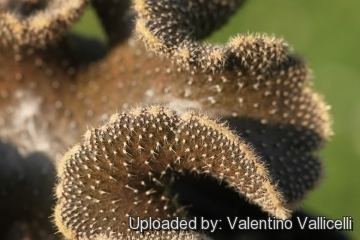Accepted Scientific Name: Pterocactus valentini Speg.
Anales Soc. Ci. Argent. 48: 51. 1899

Pterocactus valentini f. cristata Photo by: Valentino Vallicelli
Origin and Habitat: Garden origin (nursery produced cultivar). The original natural habitat of this species is the southern regions of Argentina (Chubut, Neuquen, Mendoza and Valdez peninsula).
Synonyms:
See all synonyms of Pterocactus valentini
back
Accepted name in llifle Database:Pterocactus valentini Speg.Anales Soc. Ci. Argent. 48: 51. 1899Synonymy: 4
back
Description: Pterocactus valentiniSN|19631]]SN|19631]]i is a geophyte cactus, little branched from the base and cespitose. It is very polymorphous. Some plants has flattened spines remembering those of the genus Toumeya.
Crested form: The crested form (Pterocactus valentiniSN|19631]]SN|19631]] f. cristata) - despite to its beauty - is very rare and sought after by collectors. It is a strong growing cactus with intricately undulating fan-shaped branches forming a snaky ridge or crowded cluster.
Stem: Thin, fleshy, glabrous, fan shaped with indistinct wavy ribs (not winged), brownish-purple.
Roots: Tuberous or subtuberous, but rather small, 2-4 cm long.
Areoles: Without wool
Spines: Inconspicuous all hyaline, yellow to nearly black,somewhat fattened and retroversely plicate.
Flowers: Not seen
Fruits: Not seen
Subspecies, varieties, forms and cultivars of plants belonging to the Pterocactus valentini group
 Pterocactus valentini Speg.: has thick, stem-segments tapering at both ends 4-8 cm long green to brownish-purple that breaks off easily. Tuberous root rather small, 2-4 cm long. Distribution: Chubut, Neuquen, Mendoza and Valdez peninsula, Argentina.
Pterocactus valentini Speg.: has thick, stem-segments tapering at both ends 4-8 cm long green to brownish-purple that breaks off easily. Tuberous root rather small, 2-4 cm long. Distribution: Chubut, Neuquen, Mendoza and Valdez peninsula, Argentina.  Pterocactus valentini f. cristata hort.: crested form. Cultivated.
Pterocactus valentini f. cristata hort.: crested form. Cultivated.
Bibliography: Major references and further lectures
1) Nathaniel Lord Britton, Joseph Nelson Rose “Cactaceae: Descriptions and Illustrations of Plants of the Cactus Family” Courier Dover Publications, 1963
2) Edward Anderson “The Cactus family” Timber Press, Incorporated, 2001
3) James Cullen, Sabina G. Knees, H. Suzanne Cubey "The European Garden Flora Flowering Plants: A Manual for the Identification of Plants Cultivated in Europe, Both Out-of-Doors and Under Glass" Cambridge University Press, 11/Aug/2011
4) David R Hunt; Nigel P Taylor; Graham Charles; International Cactaceae Systematics Group. "The New Cactus Lexicon" dh books, 2006
5) Haustein, Erik “Der Kosmos-Kakteenführer” Kosmos (franckh-kosmos) 1998 ISBN: 3440076857
6) Edgar Lamb, Brian Lamb “The Illustrated Reference on Cacti & Other Succulents” Volume 5 Blandford Press, 1978
7) John Borg “Cacti: a gardener's handbook for their identification and cultivation” Blandford P., 1970
 Pterocactus valentini f. cristata Photo by: Valentino Vallicelli
Pterocactus valentini f. cristata Photo by: Valentino VallicelliSend a photo of this plant.The gallery now contains thousands of pictures, however it is possible to do even more. We are, of course, seeking photos of species not yet shown in the gallery but not only that, we are also looking for better pictures than those already present.
Read More... Cultivation and Propagation: It is easy to grow and cold hardy as low as -5°C (or less). Need a fertile, well drained soil mix. Water the plants well and allow them to dry before watering again.
Sun Exposure: Outside full sun, but during hot summers, the cactus are subject to sun burning, so grow them in light shade, inside needs bright light, and some direct sun. During winter month, put them in a cool luminous place and encourage them to enter winter dormancy by withholding water and fertiliser over the winter as they will ethiolate, or become thin, due to lower levels of light. They are susceptible to fungal diseases if overwatered, but are not nearly as sensitive as many other cacti, especially in warm weather.
Propagation: It can easily be multiplied from cutting. Single sections are taken off, dried and rooted. It is also grafted on strong columnar species.











